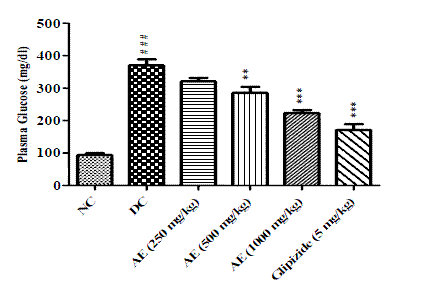Effect of standardised Bauhinia variegata extract in type II diabetic rats. Bauhinia variegata is an important medicinal plant in Ayurveda- traditional system of medicine in India. Leaves of the plant have been reported for presence of flavonoids. Now it is well evident that flavonoids have significant antidiabetic effects (1). The present study was aimed at evaluating aqueous extract of leaves of Bauhinia variegata (AE) for its antidiabetic activity in type II diabetic rats. Aqueous extract of leaves was prepared by maceration technique. The aqueous extract showed presence of total flavonoids 9.44 ± 1.96. HPTLC analysis of AE showed presence of 0.17 ± 0.03 % w/w of quercetin. .The animal study protocol was approved (no- CPCSEA/IAEC/SPTM/P-35/2013) by Institutional Animal Ethics Committee which was formed in accordance with norms of Committee for the Purpose of Control and Supervision of Experiments on Animals (CPCSEA), India. Type II diabetes was induced in male Sprague-Dawley rats by combination of High-Fat Diet and single intraperitoneal injection of low-dose (35 mg/kg) streptozotocin (2). Diabetic animals were treated with AE at dose of 250, 500 and 1000 mg/kg by oral route for 28 days. One group of diabetic animals received Glipizide (5 mg/kg p.o.) as standard treatment. Animals in diabetic control received normal water. Plasma glucose and body weight of animals were assessed weekly while biochemical parameters, plasma insulin were estimated at end of study. Oral glucose tolerance test (OGTT) was also performed on 28th day. Treatment with AE at dose of 500 and 1000 mg/kg lowered the plasma glucose level significantly to 285.5 ± 18.33 mg/dl (p<0.01) and 222.6 ± 09.51 mg/dl (p<0.001) respectively, when compared to diabetic rats (370.30 ± 18.25 mg/dl) (Figure 1). Treatment with AE also decreased the elevated plasma cholesterol (TC) and triglyceride level (TG). Treatment with AE was found to increase the high density lipoprotein (HDL) level in plasma. OGTT showed improved glucose tolerance after AE treatment. AE did not show any significant effect on plasma insulin. Table 1: Effect of AE on biochemical parameters
Figure 1: Effect of AE on PGL
###p <0.001 compared to normal control. *p < 0.05, **p< 0.01, ***p < 0.001 when compared with diabetic control. (Student’s t test) From the present study it can be concluded that the aqueous extract of leaves of Bauhinia variegata have potential antidiabetic effect, which may be linked with presence of flavonoids |


